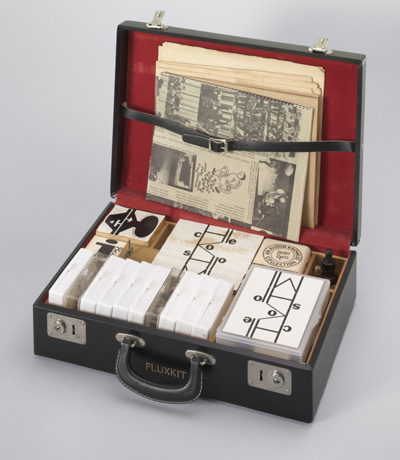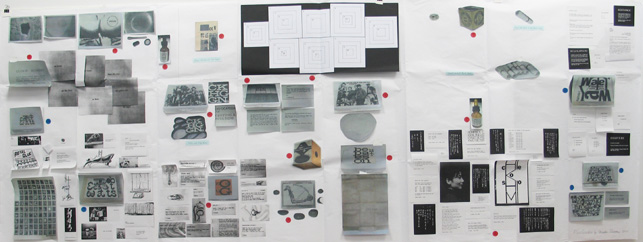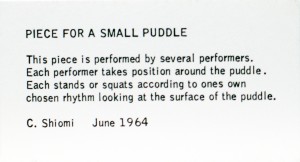Case Study:
Mieko Shiomi Interprets Fluxkit

Fluxkit. 1965. Fluxus Edition announced 1964. The Museum of Modern Art. The Gilbert and Lila Silverman Fluxus Collection Gift
The opening of Thing/Thought: Fluxus Editions, 1962-1978 did not end on the evening of September 21, 2011. As part of the exhibition (on display in The Paul J Sachs Prints and Illustrated Books Galleries through January 16, 2012), six artists have been invited to participate in the exhibition’s organization by “unpacking” and arranging two Fluxkits—the signature compilation of objects by many Fluxus artists stored in black suitcases assembled by George Maciunas, a central organizer and participant. At different points throughout the run of the show, new artists will pull from the kits’ bounty—from posters to lentil beans—and have a hand in the making of this ever-evolving exhibition.
Of the line-up, which includes Alison Knowles, Dora Maurer, Anna Ostoya, Cory Arcangel, and William Pope.L, the first to put the kit to task is one who knows its form well: Mieko Shiomi. The Japanese-born composer and visual artist spent the early years of her career challenging her training as a classical musician. Exploring new possibilities of sound and composition, Shiomi famously made music with instruments’ unused parts. After rubbing shoulders with Tokyo-based artists who had spent time abroad in the early 1960s, including Nam June Paik, Yoko Ono, and Toshi Ichiyanagi, Shiomi left her native Japan, and joined the growing contingent of Fluxus artists in New York. Of the works that Shiomi created while working with Maciunas in New York, three (Endless Box, Events and Games, and Water Music) are components of the kits on display.

Left: Mieko Shiomi’s arrangement of Fluxkit; right: Installation view of Thing/Thought: Fluxus Editions 1962–1978
Although Shiomi’s stay with the Fluxus community in New York was short-lived, she has always overcome the limitations of her locality by embracing the mail service as a means for collaboration and artistic production. True to her ways, Shiomi sent the plans for her current arrangement for the Fluxkit to us from her home in Osaka via the U.S. postal service. Upon unfolding the long, scroll-like plan, my colleagues and I stood in admiration at the painstaking effort she put into the placement of each work. Shiomi’s masterful arrangement fills the cases entirely, and is ordered according to a system of grid-lines that distinguish each artist’s work from the next, while embedding them in a myriad of constellatory relations. While Shiomi certainly did not empty the Fluxkit suitcase entirely (and thus did prioritize certain works over others), the lyrical arrangement of the kit’s contents appears non-hierarchical—making one wonder what, in particular, Shiomi’s discerning hand adds to our understanding of the works before us.

Mieko Shiomi's plan for her arrangement of Fluxkit. © 2011 Mieko Shiomi
If meaning does not pop out blatantly before our eyes we may need to linger, look, and listen a little differently. We may even need to follow the artist’s lead. The instruction card shown on the right—from Shiomi’s Events and Games, which is on display in the kit—may shed some light on her approach to arranging the kit.

Mieko Shiomi. Piece for a Small Puddle from Events and Games. 1964. Fluxus Edition announced 1963. The Museum of Modern Art. The Gilbert and Lila Silverman Fluxus Collection Gift. © 2011 Mieko Shiomi
If nothing else, perhaps what we may glean from Shiomi’s display is the particular rhythm of its form—the way she peered upon the “puddle” of papers, cans, and cards. Like the event itself, Shiomi’s process concerns looking both intently and with multiple perspectives.
